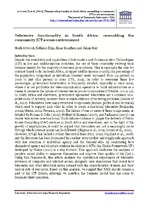| dc.description.abstract | Despite the availability and capabilities of Information and Communication Technologies (ICT) in low and middle-income countries, the use of these constantly evolving tools remains limited for the majority of resource-poor citizens. This is especially the case for internet-based tools. In South Africa, an upper middle-income country, the percentage of the population categorised as individual 'internet users' increased from 5.4 percent in 2000 to just 18.0 percent in 2010 (ITU, 2011). In order to overcome these low percentages, government intervention is frequently adopted, especially in rural areas, where it is not profitable for telecommunication operators to build infrastructure as a means to promote the uptake of internet use in poorer communities (USAASA, 2009: 47). In South Africa and elsewhere, government sponsored telecentres are a common non-profit mode of delivery, however there is much evidence of recurring problems (Gomez et al., 2012). Telecentres have many structural components (human, political and technical) which need to support each other in order to create a functional telecentre (Benjamin, 2001a; Heeks, 2002; Proenza, 2002). The failure of one or more of these components, as detailed by Roman & Colle (2002), Hulbert & Snyman (2007), and Parkinson (2005) can render telecentres non-functional. Such failures continue to plague the delivery of Public Access Computing (PAC) services in South Africa and elsewhere; and in the light of the growth of smartphones, it could be argued that telecentres are not a meaningful mode through which internet access can be delivered (Chigona et al., 2011; Gomez et al., 2012). However, ICT4D has lacked a robust theoretical base (Flor, 2012; Urquhart et al., 2008) and the literature has been dominated by a rather 'structuralist' and supply-side approach with less attention to individual agency and the demand-side. By considering how elements of agency and structure combine in relation to ICTs, the Choice Framework (CF) developed by Kleine (2010) is a step forward. This approach facilitates the analyses of people's varied ability to empower themselves and improve their quality of life (QoL). Using this Framework, this article analyses the operational experiences of telecentre provision of computer and internet access, alongside user experiences that reveal how telecentre and other structural issues interact with the characteristics of users and their various sets of resources. Based on this analysis, we suggest that PACs should remain a part of the ICT debate, although we question the business model that has come to dominate their operation. | en_US |

